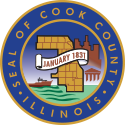Cook County Approves Solid Waste Management Plan
Today the Cook County Board approved President Preckwinkle’s Solid Waste Management Plan (SWMP) for suburban Cook County, the first plan generated in 12 years. The SWMP outlines the county’s current level of waste generation, disposal and recycling, and makes recommendations for improvement.
President Preckwinkle’s 2012 Plan reimagines traditional solid waste planning. Instead of focusing on landfilling and waste-to-energy conversion, the SWMP first recommends source reduction (preventing waste in the first place), then reuse, then recycling, followed by energy recovery. Landfilling is a last resort.
“We have a responsibility to the residents of Cook County, and future generations, to employ creative and aggressive measures to reduce solid waste in our communities,” President Preckwinkle said. “Our Solid Waste Management Plan is taking the first step in meeting this environmental challenge, and we are working toward a visionary goal of 100% waste diversion from landfills.”
Cook County Solid Waste Action Plan--Passed 4/3/12
View more presentations from cookcountyblog
Only one active landfill remains in Cook County. The landfill, located in Dolton, has only seven more years of capacity. Cook County residents spend increasing amounts of money to ship their garbage longer and longer distances, with negative environmental and economic consequences. \
Reported recycling rates in suburban Cook County in 2009 ranged from 46% from the Solid Waste Agency of Northern Cook County, 11% from the West Cook County Solid Waste Agency, and 21% from the South Suburban Mayors and Managers Association. However, information on recycling is difficult to obtain, and one of Cook County’s goals is to better understand the waste stream, what it is composed of and where it is going, to help develop better programs. “The Illinois Environmental Protection Agency only requires a goal of 25% recycling but based on the experience of other counties, higher rates are possible,” said Cook County Chief Sustainability Officer Deborah Stone. “The administration’s plan would harness the power of 128 communities within Cook County to work together to tackle the solid waste problem.” Key elements of the new SWMP include:
- More reuse of building components and demolition materials, which according to the Illinois Recycling Association amounted to over 1.7 thousand tons in 2007, the single largest component of Cook County’s waste stream going into landfills.
- Promotion of backyard composing. Landscape waste, along with other organics such as food scraps, amounted to over 1.5 thousand tons in 2007, the third largest component of the waste stream after building debris and paper.
- Creation of sites where residents can bring their old electronics for disposal. State law made landfilling of electronics illegal after January 1 of 2012.
State law requires the county to create a SWMP update every five years. Today’s approval of the plan puts the county back in compliance with state law. It also makes the county eligible for potential new grants and revenue from the state. The SWMP was created in cooperation with three solid waste associations in suburban Cook County: the Solid Waste Agency of Northern Cook County, the West Cook County Solid Waste Agency, and the South Suburban Mayors and Managers Association.
The document was prepared by The Delta Institute, a nonprofit center of innovation that creates market opportunities to achieve environmental sustainability and green jobs. In creating the Plan, the County Board held a public hearing to solicit comments from county residents. Many of the comments were incorporated into the plan.
